
By Johanna Comisak Rhodes
Find photographs and more by visiting the MCLIB Boy Scouts of America Troop 1 Digital Collection
During the year of 1910, newspapers across the country, including those in Paducah, occasionally mentioned Boy Scouts in connection with General Baden-Powell’s development of the concept in Great Britain. Soon that concept crossed the Atlantic, and Scout troops began springing up across the U.S. It was inevitable that Scouting would come to Kentucky, and then, to Paducah.
On Saturday, December 10, 1910, The Paducah Evening Sun had one line on Page 4 under the heading “Kentucky Kernels,” simply noting, “Boy Scouts organize at Lexington.” Nine days later, the same column reported, “Owensboro will have Boy Scouts.”
It seems as though the mention of “Boys Scouts” would soon become part of marketing campaigns for sales. For example, Success Magazine had an ad touting an article detailing the “Boy Scout Movement” to pump up holiday sales of the magazine. It sought to reach Christians and parents who didn’t know what to do with their “boys.” Here is part of the ad appearing on Page 2 of The News-Democrat on Tuesday, December 13, 1910:
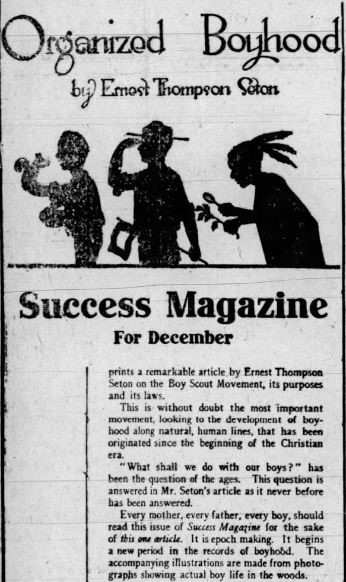
Six weeks later, The Paducah Evening Sun reported on the progress of the Scout movement in Louisville (Wednesday, February 1, 1911, Page 8):
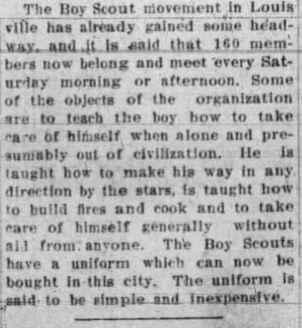
And, then it was Paducah’s turn. The first mention of Boy Scouts and Paducah came in a short article on Page 12 of The News-Democrat on February 26, 1911:
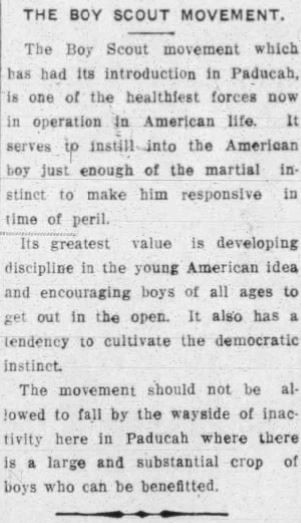
It is interesting that as Scouting began to be taken up in communities across America there were those who associated it with being somewhat militaristic. This aspect caused a few to shy away from the movement in the beginning. Even in Paducah, it is said that a major civic group approached as a possible sponsor declined. No confirmation of this, however, has been found in the Paducah newspapers of the time.
In spite of this needless concern, Boy Scouts quickly received the endorsement of church communities. At Broadway Methodist in Paducah, the Rev. G. T. Sullivan was reported to have mentioned the Boy Scouts in a Sunday sermon, “appealing to parents for their moral and spiritual support of the boys of the country.” (The Paducah Evening Sun, Monday, February 27, 1911, Page 3)
The next month, it was reported on the front page of the Evening Sun that indeed, Boy Scouts had now been organized in Paducah, as we see in a portion of the report from Monday, March 20, 1911:
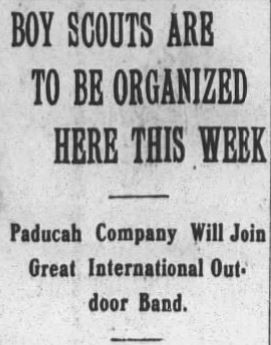
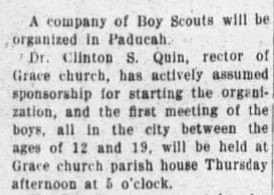
The article noted that, “The oath and work of the Scouts are just such as will interest a boy, and develop him physically, mentally and morally at the same time.” The simplicity of the times was shown by further discussion of the moral aspect. “The effect on the boys morally, is that instead of suggesting evil things for them to do by forbidding them, they are kept from evil habits by the necessity of abstaining for the purpose of qualifying in physical and mental tests.” The article also said a “council of adults” would be appointed to help with the scouting program.
The next day, the Evening Sun even had an editorial of sorts supporting the movement as one that could help parents with “problem boys.” (Tuesday, March 21, 1911, Page 4) Under the headline of “Saving The Boys,” the writer was rather dramatic. “Paducah parents whose growing boys, just entering that maelstrom of adolescence, are beginning to prove a problem to them, could do nothing better than to see that the boys join the Boy Scout company.” The writer went on. “The natural inclinations of a child are not inherently bad or inherently good; but rather capable of becoming bad or good, just as they are directed,” and he posed the question, “…isn’t it better to make the boys feel that it is a pleasure to do right?” Answering his own question, he pointed to the Boy Scout movement as being able to give ”true expression to the boy spirit and initiative.”
In conclusion, the writer gave one last endorsement. “The Boy Scouts is no untried theory, no passing fad; but a scientifically developed idea that has proven eminently practical and saved thousands of youths just at the age, when half of them usually are ruined for life.”
The Evening Sun also ran a news story on Page 1 that day with a more sedate headline: “Boy Scout Movement is Educational Fun.” It did note that the Boy Scout movement was “traveling like a prairie fire,” but the story soon settled down into discussing the positives of the movement. “The aim of the Boy Scouts (is) to supplement the various existing educational agencies and to promote the ability (of) boys to do things for themselves and others.” This would be accomplished by using a method called “Scout Craft,” which the writer said “consists of first aid, life saving, tracking, signaling, cycling, nature study and other instructions.” Perhaps this is the “scientifically developed idea” the editorial pointed to.
In any event, it was said that everything was accomplished through “games and play and is pleasure, not work, for the boys.” And all that was needed was the “out-of-doors, a group of boys and a leader.” Who wouldn’t want to be part of such an appealing group?
The News-Democrat had an article that same day on the front page of the paper with this headline:
BOY SCOUTS WILL
FORM A COMPANY
IN THIS CITY
______
Rev. Clinton S. Quinn Takes
Necessary Steps to Organ-
ize Militant Young America
Into National Body.
It would appear that the headline writer was trying to put some sizzle in the story by suggesting the country’s youth were “militant,” but the article didn’t live up to the hype. It simply noted that there would be a meeting on Thursday at 5 o’clock at Grace Episcopal Church where the rector, Clinton S. Quin, “will probably organize a large class of youngsters.”
These news accounts stirred enough interest to bring out 26 youth between the ages of 12 and 15 who “pledged their support” to the movement, according to the News-Democrat, which carried the story on the front page of the Friday, March 24, 1911, paper.
The Evening Sun pushed the news to the second page but spent time explaining the Scout hierarchy of Tenderfoot, Second Class and First Class Scouts and discussing the Scout objectives of “endurance, self-reliance, self-control and helpfulness” as well as the Scout virtues of “discipline, obedience, neatness and order.”
The writer also answered the militarism question by stating, “It (Scouting) does not teach militarism. Though it cherishes the military virtues.” And it was noted that it was not a church organization, that the initial meetings were being held at the Grace Episcopal parish house because it was “a convenient place to organize.” Besides, the rector was the person who called the meeting. Here is more from the article, including the list of youth who signed up at this first gathering.
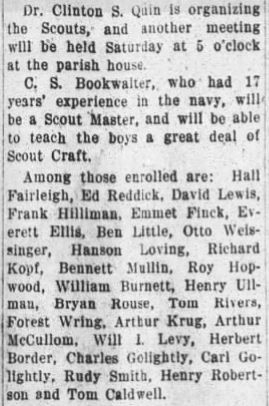
The News-Democrat also printed “Boy Scout Laws” in a box on the front page. These might surprise you. The paper did not say where they found these guidelines.

As the newspapers were carrying stories of organizational meetings of the Boy Scout movement in Paducah, Rev. C. B. Quin was working behind the scenes to make everything official. A report in the historical data saved by Paducah’s Troop 1 gives March 23, 1911, as the official organization date for the troop. Rev. Quin applied for and received a charter for the group.
For those interested in where Paducah’s Troop 1 comes in the list of oldest organized troops across the country, it is tied for fifth, along with East Hartford, Connecticut. This was verified in 2000 by Leroy G. Jossell, Director of Registration Services with the National Office of the Boy Scouts of America, headquartered in Irving, Texas. We mentioned that newspaper reports indicated that Lexington, Louisville and Owensboro all started organizing Boy Scout groups before Paducah did, but they all received their charters after Troop 1. Louisville was officially organized two months after Paducah according to Leroy G. Jossell, making Paducah’s Troop 1 the oldest in the state of Kentucky.
Back to the beginning of Paducah scouting. By Monday, March 27, 1911, the Evening Sun was reporting on the front page that Boy Scout “enlistments now number 50 boys,” and that there would be another Scout meeting at Grace that afternoon.
The next day, the News-Democrat said, “All of the applicants for membership of this famous band of boys were able to meet the requirements of a ‘Tenderfoot’ and entered upon their work earnestly.” Tenderfoot is the first level in scouting. The article said a Boy Scout manual had arrived.
In this initial stage in Paducah, there were frequent meetings, and the Evening Sun reported that a meeting had been called for April 1 to organize a council of adults that would represent “the city, the departments, the churches, and various organizations…” Here is part of the front page story the Evening Sun carried on the day of the meeting, showing the broad support.
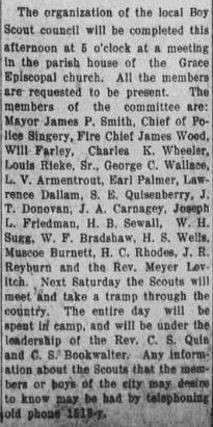
It seemed the Boy Scout movement in Paducah had indeed taken off, and there was yet again another crucial meeting called for Monday, April 2, 1911 at the parish house (News-Democrat) because Rev. C. B. Quin needed help. There were now 60 boys wanting to be in the program. “This large number cannot be instructed by one man,” said the paper, “and Rev. C. B. Quin has issued an urgent request that young men between the ages of nineteen and twenty-five from the different churches be present at the meeting….” The story continued, “A clear explanation of the boy scout plan will be made and young men are wanted to assist this splendid army in getting under way.” The reporters just couldn’t resist comparing scouting to the military. In fact, the headline on this small addition to the paper’s front page read “Wanted: Captains, Colonels and Privates.”
The council of six members was appointed, with Charles K. Wheeler` as chairman. (News-Democrat, Tuesday, April 4, 1911, Page 1) “The committee will be empowered to form committees to enlist Boy Scouts throughout the city and to give publicity to the organization,” the paper noted.
A more detailed account was published on the front page by the Evening Sun the same day. “The following Scout Masters were added to the roster yesterday: Ernest Bell, Fain King, George Rock, and J.C. Cheek. The committee is composed of the Hon. Charles K. Wheeler, chairman; Robert Wallace, Lawrence Dallam, Dr. W. A. Fite, Dr. E. B. Landis, Prof. W. H. Sugg and L. V. Armentrout.”
Delving into Scout particulars, the news account stated, “They have signals, a sign language and a code alphabet.
“They have certain obligations of loyalty, honor, courtesy, obedience, helpfulness, thrift and cleanliness.
“They must know how to save lives, to save money, save their breath and to save steps. To do these things they practice scout craft, which makes their motto ‘Be Prepared,’ a practical, guiding principles of life.”
The story also said the Scouts would soon “be uniformed and try a camping tour.”
On Thursday, April 6, 1911, another Page One article in the News-Democrat said, “…suits for the present members were ordered and they will probably arrive before Saturday, when the scouts will take a trip to the country for a few hours camping.”
A story the next day in the News-Democrat said the Paducah troop had “received a class of six into the Boy Scouts, making a total of about 70 who have taken the Boy Scout oath and ‘Tenderfoot’ degree.” It also gave more details about the Saturday outing. “…the company will set out for a five-mile jaunt to the country via the Pines road. The Scouts will spend the entire day camping, returning home late in the afternoon.” The paper had a follow-up story on April 9. Thirty-five Scouts attended.

Even before the Scout uniforms arrived for the Paducah troop, Weille’s department store began advertising that they carried official uniforms.
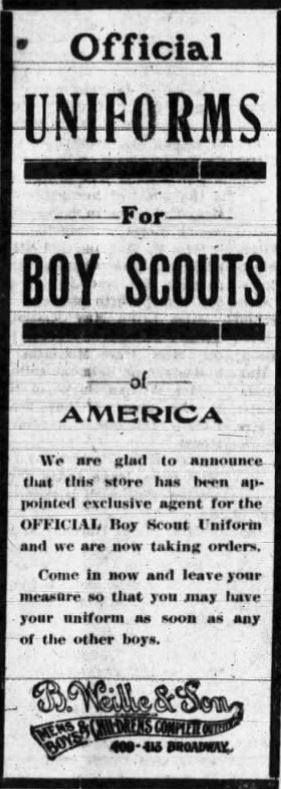
On April 22, 1911, Rev. C. S. Quin took about fifth Scouts on a hike of “more than seven miles to a shady nook on the banks of Clark’s River.” (News-Democrat, Sunday, April 23, 1911, Page 4) Most of the boys were said to have played baseball, while others went fishing. “Shortly before their departure for the woods, five new candidates were taken into the order. All of these made the trip.”
News of Paducah’s Troop 1 continued to appear almost daily in the Paducah Evening Sun and in the News-Democrat. The papers reported when about three dozen of the Scouts ran a 12-minute mile (one of the tests for the second Scout degree), when they watched a Red Cross demonstration on first aid, when they rode a train to Hazel, Kentucky and then went to Paris, Tennessee to spend the day with Scouts from Tennessee, and when they formed a baseball team to play against other Paducah teams. It was quite obvious that Boy Scouting was here to stay in Paducah.
Earlier in this narrative, we gave the newspaper listing of youth who signed up to become a Scout in the early days of recruitment in Paducah, and now we will give the official first list found in the Troop 1 archives. We cannot account for the fact that none of those listed in the newspaper in March of 1911 appear on this list. Of course, we don’t know the criteria for appearing on the official list. In alphabetical order they were:
James Friedman (1911-1914), Wilson Gleaves (1911-1914), Forrest Hunt (1911-1914), George Katterjohn (1911-1914), Russel Martin (1911-1915), Sinnot Meyer (1911-1915), Emmet Quick (1911-1915), Albert Quisenberry (1911-1914), Whitfield Quisenberry (1911-1914), Henry B. Robertson (1911-1914), Hunter Weissinger (1911-1914), James Wilhelm (1911-1914).
Troop 1 was not the only Boy Scout troop to form in Paducah. There were others, primarily sponsored by other churches in the community. We have only followed the history of Paducah’s Boy Scout Troop 1 for a few months in its beginning year. There are many more accounts in the newspapers. For instance, the Scouts took a train to Mammoth Cave in 1915, and their 2-week campout was cut short by the weather. That trip is depicted in the floodwall mural titled “Evening Roll Call,” unveiled in 2010, to celebrate the 100th year of scouting in Paducah. The mural was the idea of a prominent Paducah civic organization. You can find out which one by continuing this research.
We invite the reader to learn more about Boy Scouts in Paducah by using Newspapers.com, which is available in the Local and Family History room at the McCracken County Public Library. Here, you will find Paducah newspapers from 1896 to 2023. In addition, there are city directories online in our digital collection and at the library where you can look up some of the names of Scout leaders and Scouts you see here, to determine where they lived, what job they held (adults) and other members of their families. Research tools are at your finger tips. Be sure to check out the new Troop One collection in our online digital collection.